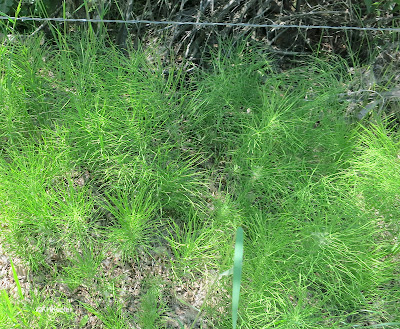Horsetails are odd enough that long ago when I knew very few plant names, I saw one and asked "what is this?" The hollow jointed stems are not like much of anything else. I learned not just that it was a horsetail, but that its an ancient plant. My college textbooks spoke of fossiles from the Carboniferous, 300 million years ago, that are virtually unchanged in structure; the genus Equisetum might be the oldest surviving genus of plants on earth. There were horsetails 60 feet (18 meters) tall. Today there are still some in Mexico and Central America that grow to 20'. Wow.
 |
| Equisetum, horsetails |
Most living fossils, plants and animals that seem unchanged in millions of years, are tropical or marine, not organisms I that live where I live. As a college student I stuck horsetails into that "odd but rarely seen" category.
But that is not true for horsetails. They are incredibly widespread, basically worldwide and can be quite abundant in a favorable habitat.
 |
| lots of horsetails in this forest |
Equisetum is a member of a plant group so old that today there is only 1 genus in the only plant family in the order Equisetales. Its relatives have all died out. There are, however, 18 species in the genus Equisetum, 11 species and at least three hybrids in North America. The distribution maps show them ALL OVER North America, clear to the Arctic Circle. The Flora of North America says they like moist places, then lists eight moist places: riverbanks, lakeshores, roadsides, ditches, seepage areas, meadows, marshes, and wet woodlands. From my experience, horsetails' idea of a wet area can be surprising: I have seen them as a component of the sandhills prairie in western Nebraska, on a dry sandy hillside in a place with about 20" of rain annually (photo below). Perhaps there was a seep.
 |
| horsetails in Nebraska sandhills prairie |
 |
| Horsetails- fertile shoots |
 |
| horsetails, Equisetum - fertile shoots, although the picture doesn't show many except in the upper left |
Horsetails have a long history of use as medicines. Europe has many of the same species of horsetail as North America. Because of the coarse texture they were used to stop bleeding. They were applied topically to cure skin inflammations. Eaten, they promoted urination and treated ulcers. German Commission E, testing traditional remedies with modern experimental design, found horsetails effective for treating several kinds of edema as well as bacterial infections of the lower reproductive tract. The American WebMD reports no accepted uses of horsetail as a medicine. I don't know enough to explain the discrepancy. Note that consuming too much horsetail can cause poisoning and they are a recognized hazard to horses. I conclude this is a valid medicine and, like all powerful medicines, should be used under expert guidance.
One of the widespread species, Equisetum hyemale, has so much silicon in its tissues that it was commercially traded to polish metal.
And, you can grow them as ornamentals. The photo below, from Mexico City, seems very successful. Notice, though, that the plants are trapped between the wall and the pavement; horsetails spread vigorously by rhizomes ancd can be troublesome weeds.
 |
| Horsetails as a border, Mexico City |
Comments and corrections welcome.
References
Glenn, L. 2014. Herb Clip News Equisetum, horsetail. American Botanical Council. link (Accessed 5/28/23 via subscription).
Hauke, R. L. 2022. Equisetum Linnaeus. Flora of North America link ((Accessed 5/26/23).
In Defense of Plants. 2015. Ancient Equisetum. In Defense of Plants blog link (Accessed 5/28/23)
Stevens, P. F. (2001 onwards). Angiosperm Phylogeny Website. Version 14, July 2017 [and more or less continuously updated since]. link (Accessed 5/25/23)

A spelling fix in the 8th graf: Equisetum hyemale sted hymale.
ReplyDeleteYes. Thanks. Fixed it.
Delete